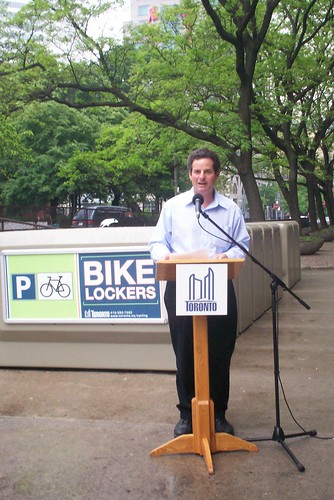A couple days ago I wrote about the restructuring of the cycling commitee, in a blog entry called: Happy Bike Week! And, here's a sharp stick in the eye...
Then, my I Bike TO colleague Darren received some comments back from Councillor Heaps, the new chair, that can be read here.
Some of the answers (below) that he provided to me are similar.
Q: How does reducing the number of citizen members on the committee "ensure that the committee assume a more active role in advocating the needs of the cycling community"?
A: There is no city committee that has 22 members which equals half of council. The new role of the TCC is to act as an"executive" committee tapping into the diverse expertise of cycling specialists and advocacy groups as dictated by the priorities which will be set by the committee. Under the new City of Toronto Act, committees have more authority to direct and utilize staff, however this means staff have more work to do and therefore we have to be more efficient on how we manage our ration of time and resources. Reducing the numbers does not reduce the responsibilities nor does it reduce the participation. It means that the committee will not be addressing every concern simultaneously which has been an impediment in the past.
Q: I also wonder why you would like to reduce the roll of the organizational representatives to being simply being consultants? (We already function as external 'consultants' via advocacy work like this, for
example. formal meetings are the only way to harness volunteer expertise, in my experience anyway!)
A: We have no intention of reducing the role and this kind of view is premature until people see how the new committee structure works. Once again cycling is part of our transportation system, and we need to understand that it has to be woven into the overall transportation vision for the city. I would hope that everyone on the new committee will be an "advocate" for cycling and its role within the city. The committee as mentioned will be operated through delegation of activities and projects to specific members of the committee who will in turn coordinate and work with the relevant advocacy groups and interested parties on that specific project.
Q: Would you not want TCAC to meet at least the same number of times as the Planning and Growth Management Committee it reports to, in advance, of
their general meetings? Just seems obvious to me.
A: Meeting 4 times per year does not mean we sit idle in the intervening months. Staff will require more than a month to report back and plan. The committee and the Chair reserve the right to increase the frequency of the meetings if the need arises. Secondly I expect informal meetings to take place between these periods as various projects progress.
Q: Finally, even if the existing (or former) TCC meetings were unwieldy and reaching quorum was difficult, how does that really effect the City's ability to implement safety programs and infrastructure? At the end of the
day, it is council's job - the TCC already serves as an official advisor, no?
A: It doesn't, although safety programs may not be the Number 1 issue for the committee. Council decisions depend on the credibility of each issue and its supporting documentation. I firmly believe that the respect and profile of cycling being accepted and incorporated into the city is directly dependent on how we conduct ourselves internally and externally as a committee.
Thanks,
Adrian
I met Councillor Heaps today at the Bike Locker press event (which I will be writing about soon), and he seems like a nice chap.
I also chatted with Dan Egan, who mentioned to me that there would be a big Bike Forum in July, which I see Joe has just posted about!
Man, we're good! So, just to put it out there again, this big Bike Forum, where we can all give our input on what we want the new committee to look like is on July 7th at Metro Hall.
More to come...
Crossposted to Spacing



